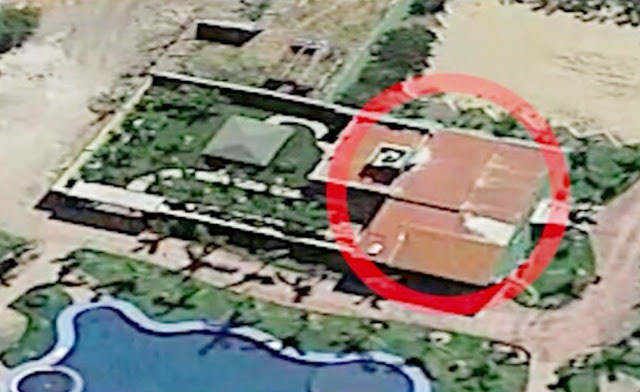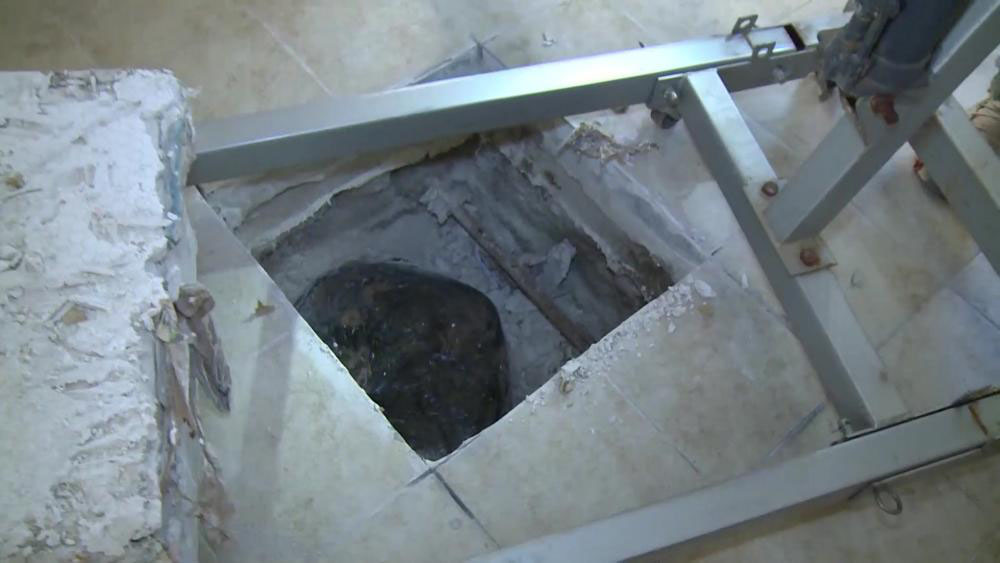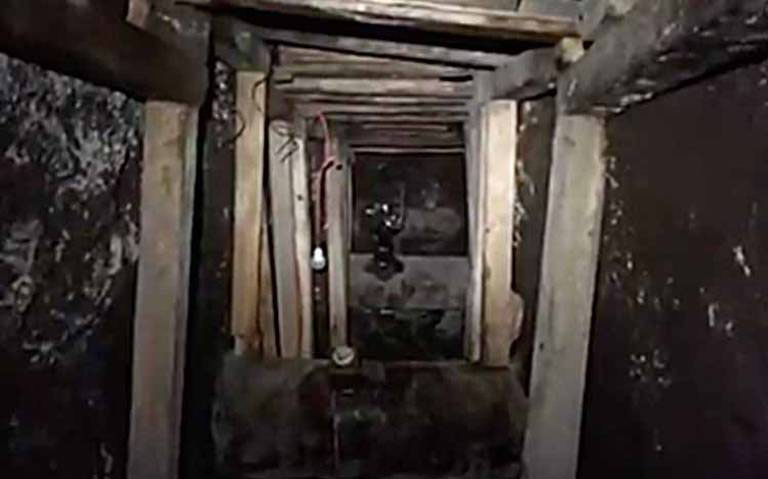Mexican Cartel Tactical Note #40: Cártel Santa Rosa de Lima (CSRL) Tunnels in Guanajuato Highlights Tactical Considerations in Underground Operations
John P. Sullivan and Robert J. Bunker
Officials in Guanajuato (Gto.) state have confirmed that alleged huachicolero (fuel theft) capo José Antonio Yépez Ortiz, known as “El Marro,” is believed to have eluded capture on Monday 6 March 2019 by escaping through a series of tunnels. The presence of a functional tunnel network to further fuel theft operations by the Cártel Santa Rosa de Lima (CSRL) illustrates the tactical complexities of underground/tunnel operations in counter-cartel operations.
Key Information: “Search for Santa Rosa cartel boss goes underground; luxury home seized.” Mexico News Daily. 7 March 2019, https://mexiconewsdaily.com/news/search-for-santa-rosa-cartel-boss-goes-underground/:
The search for the suspected leader of the Santa Rosa de Lima Cartel has gone underground: authorities in Guanajuato have discovered escape tunnels allegedly used by the fuel theft capo known as “El Marro.”
Guanajuato Attorney General Carlos Zamarripa Aguirre told a press conference last night that the tunnels were found during searches of properties in Villagrán, the municipality where the cartel is based and José Antonio Yépez Ortiz was thought to be in hiding.
Zamarripa said the tunnels may be connected to other properties in the community of Santa Rosa de Lima where cartel members are known to have met, including one believed to be owned by “El Marro” Yépez.
Key Information: “‘El Marro’ imita al ‘Chapo’ y escapa a través de túneles.” El Financiero. 7 March 2019, https://elfinanciero.com.mx/nacional/el-marro-imita-al-chapo-y-escapa-a-traves-de-tuneles:
Al puto estilo de Joaquín el ‘Chapo’ Guzmán, José Antonio Yepez ‘El Marro’, presunto líder del Cártel de Santa Rosa de Lima, usaba una red de túneles para escapar, confirmaron este miércoles autoridades de Guanajuato, de acuerdo con la agencia Quadratín.
La Fiscalía General del Estado (FGE) y la Secretaría de Seguridad Pública informaron que fue descubierta en esa comunidad una finca de al menos 8 mil metros cuadrados que usaba el grupo criminal.
El hallazgo se realizó como parte de los operativos que se realizan en la zona para detener a ‘El Marro’, señalado por participar en el robo de combustible en la entidad.
Key Information: “Confirman red de narco-túneles en Guanajuato.” Vangaurdia. 6 March 2019, https://vanguardia.com.mx/articulo/confirman-red-de-narco-tuneles-en-guanajuato:
GUANAJUATO.- El fiscal general del estado de Guanajuato, Carlos Zamarripa Aguirre, informó que con la participación de autoridades de seguridad estatal y federal, lograron la detención de seis personas más por diferentes motivos y el aseguramiento de 31 vehículos con reporte de robo en el municipio de Villagrán.
En rueda de prensa, el funcionario estatal indicó que hasta ahora hay siete personas detenidas, quienes son cercanas a José Antonio Yépez ‘El Marro’, líder del Cártel de Santa Rosa de Lima.
Dijo que las acciones siguen en Santa Rosa de Lima, municipio de Villagrán, donde además tienen informes de que el grupo delictivo ligado al robo de gasolina, cuenta con una red de túneles.
[Emphasis in the original.]
Key Information: Milenio Digital and Mariana Ramos, “Al estilo ‘El Chapo’, ‘El Marro’ usa túneles en Guanajuato.” Milenio. 6 March 2019, https://www.milenio.com/policia/confirman-existencia-tuneles-santa-rosa-lima:
En Santa Rosa de Lima existen túneles y se presume que son utilizados por integrantes del grupo criminal que lidera José Antonio Yépez Ortiz, El Marro, confirmó Carlos Zamarripa, fiscal de Guanajuato.
En conferencia de prensa, detalló que los túneles fueron localizados en por los menos ocho propiedades que fueron cateadas en dicho lugar y precisó que la finca a la que ingresaron no se trata de la casa de El Marro, pero sí un punto de reunión.
[Emphasis in the original.]
Who: The Cártel Santa Rosa de Lima (CSRL); Santa Rosa de Lima Cartel and its leader José Antonio Yépez Ortiz (“El Marro”).
What: Escape and evasion (E&E) through an underground tunnel system built underneath “El Marro’s” ranch properties and safe houses; larger issue of huachitúneles (fuel theft tunnels) developed by CSRL to siphon fuel from Pemex lines.
When: 6 March 2019.
Where: Rural ranch properties and safe houses in the municipality of Villagrán, Guanajuato (Gto.), Mexico.
Why: The use of tunnels facilitate organized criminal activities—direct (and hard to detect) theft from buried Pemex fuel distribution lines via hose taps—and allows for the covert movement of personnel, product, weapons, and cash underground between safe houses as well as providing escape routes for CSRL leadership threatened by Federal and opposing cartel (primarily CJNG; Cártel de Jalisco Nueva Generación) raids.
Analysis
The Cártel Santa Rosa de Lima (CSRL) has been engaged in sustained conflict with rival criminal cartels and public officials in Guanajuato for control of the criminal economy centered on the illicit fuel trade. The CSRL backlash against public officials has included explosive threats against local oil refineries and threats against Mexico’s president.[1] Government crackdowns against the cartel are seeking to capture the cartel’s leader José Antonio Yépez Ortiz (“El Marro”). In the aftermath of a recent cluster of fiery narcobloqueos (blockades)[2] and an attack on the federal prosecutor’s office in Irapuato, Gto.[3], federal police and military have been seeking the arrest of “El Marro.” As part of that operation, a raid launched against a safe house (believed to be occupied) uncovered a network of tunnels which are surmised to have facilitated the capo’s escape.[4]

Photo of “El Marro’s Ranch posted by Chivis Martinez at Borderland Beat, 7 March 2019. For access to video footage of the location see “El Marro’s Ranch” http://www.borderlandbeat.com/2019/03/el-marros-ranch.html.
Tunnels for Crime
While details on the interior features of El Marro’s tunnels are presently unavailable, tunnels are an integral part of both narcotrafficking and the illicit fuel trade. “El Chapo” Guzman, convicted Sinaloa Cartel leader, used tunnels extensively—most notably as a means of escape in his 2015 Altiplano prison break.[5] Tunnels are also used to transport illicit drugs and contraband (especially across the US-Mexico Border).[6]

Cross-Border Tunnel Linking Calexico and Mexicali (2016). Source: U.S. Immigration and Custom Enforcement (ICE), Defense Visual Information Distribution Service (DVIDS), https://www.dvidshub.net/video/455669/major-cross-border-tunnel-linking-calexico-and-mexicali.
Tunnels also play a key role in the theft and diversion of petroleum from Pemex fuel transmission pipelines.[7] While the idea of using tunnels to transport drugs originated with “El Chapo,” the concept has been fully embraced by fuel thieves—indeed the huachicoleros call their tunnels ‘huachitúneles.’[8]

Screenshot of huachicolero tunnel at illegal tap in Azcapotzalco, 29 January 2019. Source: Pemex from video at https://twitter.com/Pemex/status/1090387165706575873.
Here, the fuel thieves (huachicoleros) exploit tunnels in at least three ways: First, they are means of accessing pipelines to steal fuel though illicit taps (known as tomas clandestinas);[9] Second, the tunnels serve as a mode of transport and distribution chain (and to move and store the stolen fuel).[10] Finally, they use them as a mode of transport for personnel and equipment (as seen in the role tunnels play in escape and evasion (E&E) from security forces).[11]
Tactical Considerations and Threats
Operating in tunnels and underground spaces poses special risks to police and military personnel conducting enforcement, stability and support (SASO) and counter-cartel or counter-criminal insurgency operations (COCRIMIN) in ‘crime wars.’[12] Fighting in tunnels and underground spaces is unfamiliar, uncomfortable, and fraught with hazards. This is compounded by a lack of contemporary tactical and operational experience.[13]
Subterranean spaces include specially dug or constructed tunnels as seen in the classic narco or smuggling tunnels, re-purposed underground spaces (like caverns, caves, or abandoned tunnels), cellars, basements, and underground roadways and subways and commuter or freight rail tunnels.[14] All of these spaces are unfamiliar to the majority of law enforcement and military units—Mexican or otherwise. They can provide refuge and secret passageways for attackers (unconventional or otherwise), opportunities for crime—ranging from spaces for street robberies, kidnapping or levantons (through the classic use as smuggling avenues) and means of hiding, evasion, and escape.
Tunnels are dark and often wet, hot, and humid. They can contain tight spaces, low overhead clearances, and present a range of explosive and toxic environmental challenges.[15] All of these impediments are enhanced by poor visibility, darkness, impeded sight lines, and amplified noise (echoes) facilitating sensory decrements that inhibit maneuver, engagement, and situational awareness. Tunnels also degrade intelligence, surveillance, and reconnaissance complicating tactical and operational decision-making.[16] In addition to tactical challenges found in all confined space operations, illicit taps bring an additional explosion hazard both within the tunnel and in proximate inhabited spaces.
Conclusion
Subterranean spaces bring new challenges to military and police operations. The use of tunnels along the US-Mexico border and recent tunnel warfare in Israel[17] are examples of the potentials for underground conflict and combat. These underground potentials demand new skills, training, and equipment. John Spencer, Chair of Urban Warfare Studies at West Point’s Modern Warfare Institute, has developed a ‘wish list’ for urban operations tools. Ranging from a new ‘concept of operations’—i.e., a ‘new way of thinking’ for underground engagements—to new weapons (acoustic nonlethals), equipment (foam grenades, infrared ‘ropes and cords’ that act like ‘bread crumbs’ to aid navigation and unit cohesion), robots, and shovels, to dogs, lighting and sensor capabilities. Other new tools such as ‘tunnel-mapping’ and visualization tools are also needed.[18] Some of these innovations—like proposed ‘blinding’ light sources—demand scrutiny and ‘weapons review’ to ensure adherence to International Humanitarian Law (IHL).[19][20][21][22]
Underground spaces and subterranean TTPs are increasingly important dimensions of emerging conflict. Violent non-state actors, guerrillas, armed criminal bands, narcos, and, more recently, huachicoleros now exploit tunnels and challenge security and the rule of law in a range of hybrid conflicts and insurgencies (criminal and otherwise). The network of tunnels used by “El Marro” and the CSRL in Guanajuato is an important tactical footnote in this emerging trend.
Sources
“Confirman red de narco-túneles en Guanajuato.” Vangaurdia. 6 March 2019, https://vanguardia.com.mx/articulo/confirman-red-de-narco-tuneles-en-guanajuato.
“‘El Marro’ imita al ‘Chapo’ y escapa a través de túneles.” El Financiero. 7 March 2019, https://elfinanciero.com.mx/nacional/el-marro-imita-al-chapo-y-escapa-a-traves-de-tuneles.
“‘El Marro,’ líder huachicolero, usaba túneles en su mansión de lujo.” El Universal. 7 March 2019, https://www.eluniversal.com.mx/estados/el-marro-lider-huachicolero-usaba-tuneles-en-su-mansion-de-lujo#imagen-1.
Milenio Digital and Mariana Ramos, “Al estilo ‘El Chapo’, ‘El Marro’ usa túneles en Guanajuato.” Milenio. 6 March 2019, https://www.milenio.com/policia/confirman-existencia-tuneles-santa-rosa-lima.
“Search for Santa Rosa cartel boss goes underground; luxury home seized.” Mexico News Daily. 7 March 2019, https://mexiconewsdaily.com/news/search-for-santa-rosa-cartel-boss-goes-underground/.
End Notes
[1] See John P. Sullivan and Robert J. Bunker, “Mexican Cartel Strategic Note No. 27: Confronting the State—Explosive Artifacts, Threats, Huachicoleros, and Cartel Competition in Guanajuato, MX.” Small Wars Journal. 14 March 2019, https://smallwarsjournal.com/jrnl/art/mexican-cartel-strategic-note-no-27-confronting-state-explosive-artifacts-threats.
[2] “More backlash against Guanajuato security operation to find oil thieves.” Mexico News Daily. 4 March 2019,
https://mexiconewsdaily.com/news/more-backlash-against-guanajuato-security-operation/.
[3] Carlos García, “Balean instalaciones de la FGR en Irapuato, tras operativo.” La Jornada. 6 March 2019, https://www.jornada.com.mx/ultimas/2019/03/06/balean-instalaciones-de-la-fgr-en-irapuato-tras-operativo-7091.html.
[4] “Officials confirm narcotunnels in Guanajuato.” Borderland Beat. 7 March 2019, http://www.borderlandbeat.com/2019/03/officials-confirm-narcotunnels-in.html.
[5] Altiplano, formally known as Centro Federal de Readaptación Social Número 1 "Altiplano" is a high security prison near Toluca in the State of Mexico. It is known for housing narco kingpins. See, for example, Mac Schneider, “El Chapo’s drug tunnels, explained.” Vox. 12 February 2019, https://www.vox.com/videos/2019/1/29/18202097/el-chapo-drug-tunnels-trial-mexico-drug-war; Catherine E. Shoichet, “’El Chapo’ hideaways: Look inside.” CNN. 4 August 2016, https://www.cnn.com/2016/07/04/americas/mexico-el-chapo-hideaways/index.html; and Monte Reel, “Underworld: How the Sinaloa drug cartel digs its tunnels.” The New Yorker (Annals of Excavation). 3 August 2015, https://www.newyorker.com/magazine/2015/08/03/underworld-monte-reel.
[6] See Christopher Woody, “The ‘US-Mexico border is literally riddled with tunnels.’” Business Insider. 3 September 2016, https://www.businessinsider.com/inside-mexican-drug-cartel-narco-tunnels-on-the-us-mexico-border-2016-9 and “Brenda Fiegel, “Geographic Constraints of Narco-Tunnels Along the Southwest Border.” Small Wars Journal. 30 September 2016, https://smallwarsjournal.com/jrnl/art/geographic-constraints-of-narco-tunnels-along-the-southwest-border.
[7] See, for example, “Hallan túnel de huachicoleros en Toluca.” El Heraldo de México. 21 June 2018,https://heraldodemexico.com.mx/estados/hallan-tunel-de-huachicoleros-en-toluca/ and Justino Miranda, “‘Huachicoleros’ dejan gran hoyo por toma clandestine en Cuernevaca.” El Universal. 23 January 2018,https://www.eluniversal.com.mx/estados/huachicoleros-dejan-gran-hoyo-por-toma-clandestina-en-cuernavaca.
[8] Antonio Nieto, “En la CDMX se mueve el huachicol por túneles.” La Silla Rota. 16 January 2019,https://lasillarota.com/metropoli/en-la-cdmx-se-mueve-el-huachicol-por-tuneles-huachicoleo-huachituneles-azcapotzalco-pemex/266585.
[9] An extreme case was recently seen in Mexico City where an illegal tap under an industrial building tapped five separate pipelines varying in size from 8-14 inches and carrying gasoline, diesel, and aviation fuel. See Selene Flores and Estrella Álvarez, “Bloqueos tras asegurar gasolina en Guanajuato.” Milenio. 30 January 2019, https://www.milenio.com/policia/bloqueos-tras-asegurar-gasolina-en-guanajuato.
[10] Tunnels and caves are convenient hiding places to secret illicit fuel stores. See “Fue localizado escondite donde huachicoleros escondían combustible.” PacoZea. 1 June 2017, https://www.pacozea.com/aqui-escondian-combustible-los-huachicoleros-michoacan.
[11] Alan Feuer, “How El Chapo Escaped in a Sewer, Naked With His Mistress.” New York Times. 17 January 2019, https://www.nytimes.com/2019/01/17/nyregion/el-chapo-trial.html.
[12] Robert Muggah and John P. Sullivan, “The Coming Crime Wars.” Foreign Policy. 21 September 2018,https://foreignpolicy.com/2018/09/21/the-coming-crime-wars/.
[13] Many subterranean spaces are essentially confined spaces that pose dangers ranging from noxious fumes, reduced oxygen level, explosive and fire risks. They can also present flooding and drowning hazards, as well as risk of asphyxiation. See “Working in confined spaces.” Health and Safety Executive (UK) for an overview: http://www.hse.gov.uk/toolbox/confined.htm.
[14] Guanajuato itself is home to an extensive labyrinth of underground spaces, including tunnels, underground roads, underground rivers running through caverns, and underground transit. See “The Extraordinary Buried Streets of Guanajuato, Mexico.” Slice. 22 October 2014, https://www.slice.ca/travel/photos/the-extraordinary-buried-streets-of-guanajuato-mexico/#!30bf428898dac52116960924b3a9daca.
[15] See John P. Sullivan, “SWJ Book Review – “Underground Warfare.” Small Wars Journal. 21 September 2018,https://smallwarsjournal.com/jrnl/art/swj-book-review-underground-warfare and Daphné Richemond-Barak, Underground Warfare. New York: Oxford University Press, 2018.
[16] Steven Losey and Todd South, “The Air Force’s struggle to fight subterranean warfare.” Air Force Times. 12 March 2019, https://www.airforcetimes.com/news/your-air-force/2019/03/12/the-air-forces-struggle-to-fight-subterranean-warfare/ and Todd South, “The subterranean battlefield: Warfare is going underground, into dark, tight spaces.” Military Times. 25 February 2019, https://www.militarytimes.com/news/your-army/2019/02/26/the-subterranean-battlefield-warfare-is-going-underground-into-dark-tight-spaces/.
[17] Daphné Richemond-Barak. “Is Israel Winning the Underground Fight?” Small Wars Journal. 19 December 2018, https://smallwarsjournal.com/jrnl/art/israel-winning-underground-fight.
[18] Alex Hollings, “Tunnel-mapping tech may be the most important special operations gear of the 21st century.” NewsRep. 16 March 2019, https://thenewsrep.com/115273/darpas-tunnel-mapping-tech-may-be-the-most-important-special-operations-gear-of-the-21st-century/.
[19] Blinding laser weapons are prohibited under IHL. See Protocol on Blinding Laser Weapons (Protocol IV to the 1980 Convention), 13 October 1995, https://ihl-databases.icrc.org/ihl/INTRO/570 and Customary IHL Rule 86. Blinding Lasers, https://ihl-databases.icrc.org/customary-ihl/eng/docs/v1_rul_rule86 where “The use of laser weapons that are specifically designed, as their sole combat function or as one of their combat functions, to cause permanent blindness to unenhanced vision is prohibited.” Weapons that ‘dazzle’ or do not cause permanent blindness are not currently proscribed yet remain controversial.
[20] See Jeff Hecht, “Should police and coastguards use laser dazzlers?” New Scientist. 8 February 2012, https://www.newscientist.com/article/mg21328516-400-should-police-and-coastguards-use-laser-dazzlers/ and Todd South, “The future of nonlethal laser weapons: Dazzling lights to talking plasma balls.” Military Times. 22 March 2018, https://www.militarytimes.com/news/your-military/2018/03/22/the-future-of-nonlethal-laser-weapons-dazzling-lights-to-talking-plasma-balls/.
[21] On ‘weapons review for adherence to IHL’ see Kathleen Lawand, “Reviewing the legality of new weapons, means and methods of warfare.” International Review of the Red Cross. Vol. 88, No. 864. 31 December 2006,https://www.icrc.org/en/international-review/article/reviewing-legality-new-weapons-means-and-methods-warfare.
[22] A comprehensive discussion of the legal is found in Daphné Richemond-Barak, Underground Warfare. While policing and internal security operations fall under domestic criminal or penal law, unless they rise to the level of a non-international or international armed conflict, similar humane concerns and limitations of weapons authorized under various rules of engagement exist.
Significance: Cártel de Santa Rosa de Lima (CRSL)/Santa Rosa de Lima Cartel, confined space operations, crime wars, huachitúneles, narco-blockades narcobloqueos, narcotúneles, narco-tunnels, subterranean spaces, tunnel warfare, underground operations, underground warfare, urban operations, urban warfare.
For Additional Reading
Robert J. Bunker, Alma Keshavarz and John P. Sullivan, “Mexican Cartel Tactical Note #39: GoPro Video Social Media Posting of Cártel Santa Rosa de Lima (CSRL) Tactical Action against Cártel Jalisco Nueva Generación (CJNG) in Guanajuato - Indications & Warning (I&W) Concerns.” Small Wars Journal. 5 March 2019.
Brenda Fiegel, “Geographic Constraints of Narco-Tunnels Along the Southwest Border.” Small Wars Journal. 30 September 2016.
Daphné Richemond-Barak, Underground Warfare. New York: Oxford University Press, 2018.
John Spencer, “My Underground Warfare Wish List.” Modern War Institute, 19 February 2019.
John P. Sullivan, “SWJ Book Review – ‘Underground Warfare.’” Small Wars Journal. 21 September 2018.
John P. Sullivan and Robert J. Bunker, “Mexican Cartel Strategic Note No. 27: Confronting the State—Explosive Artifacts, Threats, Huachicoleros, and Cartel Competition in Guanajuato, MX.” Small Wars Journal. 14 March 2019.


